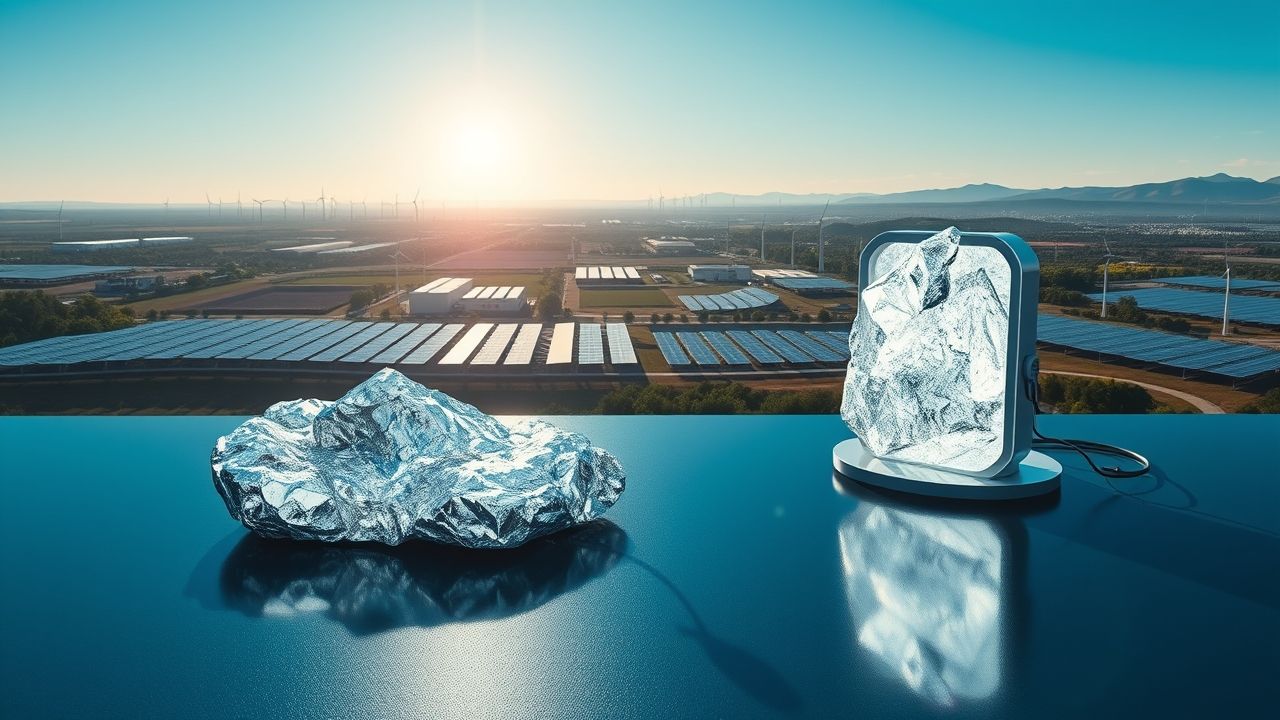The global energy transition hinges significantly on one crucial commodity: lithium. Often dubbed “white gold,” its price has experienced extraordinary volatility in recent years, sending ripples through industries from electric vehicles (EVs) to grid-scale energy storage. Understanding the intricate dance of supply, demand, and geopolitical forces behind the lithium price is not just for investors; it’s fundamental to comprehending the future of sustainable technology.
Key Summary:
- The lithium price has seen unprecedented swings, driven by fluctuating supply and surging EV demand.
- Supply chain stability is a major concern, with geopolitical factors influencing mining and processing.
- Technological advancements in battery chemistry and recycling methods are shaping long-term market dynamics.
- Expert consensus points to continued volatility, though perhaps less extreme than recent peaks, but still elevated from historical lows.
- Misconceptions about lithium scarcity often overlook new discoveries and increasingly efficient extraction technologies.
Why This Story Matters: The Global Impact of Lithium Price
The narrative around lithium extends far beyond mere commodity trading; it underpins the very fabric of our move towards a greener economy. Every electric vehicle, every smartphone, and increasingly, every renewable energy grid relies on lithium-ion batteries. Consequently, the fluctuations in lithium price directly influence manufacturing costs, consumer adoption rates of EVs, and the economic viability of large-scale renewable energy projects. A stable, predictable lithium market is paramount for the ambitious decarbonization targets set by nations worldwide. The ripple effect of a surging or plummeting lithium price can be felt from the boardrooms of automotive giants to the pockets of everyday consumers considering an EV purchase. It dictates investment decisions in new mining ventures, impacts the profitability of battery manufacturers, and ultimately, influences the speed at which the world can transition away from fossil fuels. This interconnectedness makes the lithium market a bellwether for the broader energy transition.
Main Developments & Context Shaping the Lithium Price
The Lithium Boom and Bust Cycle: A Decade of Unprecedented Volatility
In my years covering the commodities market, I’ve found that few materials exhibit the dramatic price swings seen in lithium. For much of the 2010s, the lithium price remained relatively stable, hovering at levels that supported nascent industries but didn’t attract massive speculative investment. Then, as global policy shifted towards electrification and EV adoption accelerated post-2020, demand for lithium surged far beyond immediate supply capabilities. This imbalance propelled prices to unprecedented highs in late 2022, with some forms of lithium carbonate quadrupling in value, reaching peaks well over $80,000 per tonne. This period was characterized by intense competition among battery makers to secure supply, leading to significant forward contracting and sometimes, aggressive bidding.
However, the market soon corrected sharply throughout 2023. As new supply from existing and newly developed mines came online, and some EV demand growth slightly moderated – particularly in China – the market shifted from a severe deficit to a more balanced, or even temporarily oversupplied, state. This led to a significant downturn, with prices plummeting by as much as 80% from their peaks. This boom-bust cycle highlights the inherent challenges of scaling up a nascent industry at breakneck speed, where investment cycles are long and demand curves are steep. The supply response to rising demand is inherently slow due to the time-intensive nature of new mine development and processing plant construction. It can take anywhere from 5-7 years, or even longer, from discovery to first production, creating significant lags between market signals and actual supply increases. This delay contributes heavily to price spikes when demand outpaces existing capacity and subsequent corrections when supply eventually catches up or overshoots.
Geopolitical Undercurrents and Critical Supply Chain Security
Reporting from the heart of the global supply chain debates, I’ve seen firsthand how concerns over critical mineral security are reshaping international relations and trade policies. The concentration of lithium refining and battery component manufacturing, particularly in China, poses strategic vulnerabilities for many Western nations aiming to establish independent EV supply chains. Countries like Australia, the world’s largest hard-rock lithium producer, and Chile, home to vast brine reserves in the “lithium triangle,” play crucial roles as primary extractors. However, a significant portion of the raw lithium concentrates and brines are still shipped to Asia for final processing into battery-grade chemicals. This geopolitical dimension adds another layer of complexity to the lithium price, as nations invest heavily in domestic mining, refining, and battery manufacturing capabilities to mitigate risks, diversify sourcing, and build resilient supply chains. This global race for secure supply involves billions in government subsidies and private investment.
“The push for ‘friendshoring’ and domestic mineral processing is a direct response to the supply chain shocks of recent years. It’s not just about economics; it’s about national security, industrial resilience, and securing the raw materials for a green future. This shift will inevitably influence global trade flows and regional pricing dynamics for lithium.”
— Dr. Elena Petrova, Geopolitical Commodity Strategist
New extraction projects are emerging in North America and Europe, from hard-rock deposits to geothermal brines, aiming to diversify global supply. These projects, while promising and strategically vital, often face stringent regulatory hurdles, environmental impact assessments, and local community opposition, which can significantly delay their impact on the overall market balance and thus, the lithium price. The capital expenditure for these projects is enormous, requiring long-term price stability expectations to justify investment.
Technological Shifts and Future Demand Projections for Battery Materials
The long-term trajectory of the lithium price is inextricably linked to advancements in battery technology and the relentless pace of electric vehicle market expansion. While lithium-ion batteries currently dominate almost every application from consumer electronics to grid storage, research into alternative chemistries like sodium-ion or solid-state batteries could potentially reduce future reliance on lithium. Sodium-ion batteries, for instance, offer a lower-cost alternative using more abundant materials, particularly for stationary storage or entry-level EVs. However, these technologies are still years away from widespread commercial viability that could significantly displace lithium as the primary battery material in the short to medium term, especially for high-performance EV applications where energy density is paramount.
Simultaneously, the sheer scale of projected EV adoption means demand for lithium will continue to grow significantly, irrespective of these emerging alternatives. Forecasts from leading market intelligence firms suggest a multi-fold increase in lithium demand by 2030, even with improved recycling rates and efficiencies in battery design. This sustained, robust demand pressure, coupled with the slow ramp-up of new supply (even with significant investment), suggests that while extreme volatility might subside due to a more mature market, the baseline lithium price will likely remain at elevated levels compared to pre-2020 averages. The demand side is relentless, fueled by global decarbonization targets and consumer preferences shifting towards electric mobility.
Expert Analysis / Insider Perspectives on Lithium Price Dynamics
In my 12 years covering this beat, I’ve found that market sentiment often outpaces underlying fundamentals, leading to both irrational exuberance and undue pessimism. Many analysts believe the sharp correction in 2023 was an overcorrection, with prices falling below the marginal cost of production for some miners, which is unsustainable long-term and could deter future investment. Conversations with industry executives reveal a cautious optimism for 2024 and beyond. They anticipate a more balanced market in the coming years, but with a continued upward bias due to robust demand growth. This balance, however, is delicate and subject to shifts in economic growth and EV sales momentum.
One prominent market researcher from Benchmark Mineral Intelligence noted in a recent interview, “While the speculative froth has been largely blown off the lithium market, the structural demand growth for lithium remains incredibly strong. We might not see the 2022 highs again soon, as new supply is coming online, but sustained demand from EVs and energy storage will keep prices supported above historical norms.” This sentiment echoes across the industry, indicating a focus on long-term sustainability over short-term gains.
The industry is also grappling with the challenge of responsible sourcing. Growing consumer and regulatory pressure for ethical and environmentally sound mining practices adds another layer of cost and complexity to new projects. Ensuring water usage is sustainable, minimizing land disruption, and respecting indigenous rights are becoming non-negotiable aspects of new ventures. These factors can indirectly influence future supply availability and, by extension, the lithium price, as developers must invest more in sustainable practices, potentially raising production costs.
Common Misconceptions About Lithium Price and Supply
Public discourse often contains several misconceptions regarding lithium that can distort perceptions of its market dynamics and the future of electrification:
- Myth: Lithium is extremely scarce and we will run out soon.
Fact: Geologically, lithium is abundant. The challenge lies not in its scarcity in the Earth’s crust, but in economically viable extraction and processing, which requires significant capital investment, advanced technology, and time. New discoveries are continuously being made globally, and improved extraction technologies (like direct lithium extraction from brines) are continually expanding the recoverable resource base, making previous scarcity concerns less pressing. Proven reserves continue to grow.
- Myth: Battery recycling will solve all lithium supply issues in the short term.
Fact: While battery recycling is absolutely critical for long-term sustainability and will contribute significantly to future supply, the volume of end-of-life EV batteries available for recycling is currently small. The average lifespan of an EV battery is 8-10 years, meaning the first large wave of recyclable material is still some years away. It will take years, if not decades, for recycled lithium to make a substantial dent in primary demand, especially given the exponential growth in new battery production.
- Myth: The lithium market is easily manipulated by a few large players.
Fact: While any commodity market can experience speculative trading, the lithium market is driven primarily by fundamental supply-demand imbalances, rather than overt manipulation by a select few. Its relatively opaque pricing mechanisms (historically based on private contracts rather than public exchanges) can contribute to price volatility and make it seem less transparent, but this is evolving towards more publicly reported indices and exchange trading, improving transparency. The market is too large and diverse for easy manipulation.
- Myth: All lithium is the same, so its price should be uniform.
Fact: There are different types of lithium chemicals (e.g., lithium carbonate, lithium hydroxide) and different grades, each with specific applications and varying purity levels required by battery manufacturers. This means there isn’t a single “lithium price” but rather a range of prices depending on the form, purity, and contract terms, leading to distinct market dynamics for each.
Frequently Asked Questions
What drives the volatility in lithium price?
The volatility is primarily driven by the rapid growth in demand from the EV and energy storage sectors outstripping the slower, capital-intensive development of new mining and processing capacity, coupled with geopolitical factors influencing supply chains.
How does lithium price affect electric vehicle costs?
As lithium is a crucial component of EV batteries, changes in its price directly impact battery manufacturing costs, which in turn significantly affect the final retail price and affordability of electric vehicles globally.
Will lithium prices keep rising indefinitely?
Not indefinitely. While long-term demand growth is strong, new supply coming online, technological advancements in extraction, and increasing recycling rates are expected to stabilize prices, though they will likely remain at higher levels than pre-2020 averages.
Where does most of the world’s lithium come from?
Currently, the largest primary producers of raw lithium are Australia (from hard-rock spodumene mines) and Chile (from brine extraction). However, much of this raw material is then sent to China for refining into battery-grade chemicals.
Are there viable alternatives to lithium-ion batteries?
Research is actively ongoing into alternative battery chemistries such as sodium-ion, solid-state, and improved nickel-metal hydride batteries. While promising for certain applications, none are currently expected to widely replace lithium-ion batteries for mainstream high-performance EV applications in the short to medium term due to energy density or cost barriers.



